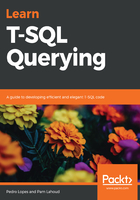
FROM
The FROM clause specifies the tables or views used in the SELECT, DELETE, and UPDATE statements. It is required unless a SELECT list contains only constants, variables or arithmetic expressions, or an UPDATE clause does not contain references to other tables other than the target (for example, a join is not needed).
It can be a single table, a derived table (a table created from a nested sub-query), a Table-Valued Function (TVF), or it can be several tables and/or views joined together.
If the desired result set contains data from more than one table or view, joins can be used to link rows from one table to another. There are essentially the following three types of logical joins that are expressed when writing a query:
- Inner joins
- Outer joins (left, right, and full)
- Cross joins
In specific scenarios, SQL Server may infer the intended type of logical join operation. However, it is best to always explicitly state the type of required logical join operation the reader intends to implement.